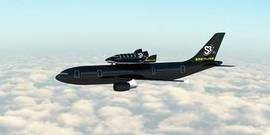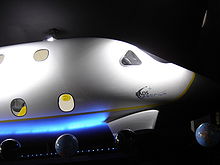
A spaceplane is a vehicle that can fly and glide like an aircraft in Earth's atmosphere and maneuver like a spacecraft in outer space. To do so, spaceplanes must incorporate features of both aircraft and spacecraft. Orbital spaceplanes tend to be more similar to conventional spacecraft, while sub-orbital spaceplanes tend to be more similar to fixed-wing aircraft. All spaceplanes to date have been rocket-powered for takeoff and climb, but have then landed as unpowered gliders.

A sub-orbital spaceflight is a spaceflight in which the spacecraft reaches outer space, but its trajectory intersects the surface of the gravitating body from which it was launched. Hence, it will not complete one orbital revolution, will not become an artificial satellite nor will it reach escape velocity.

Skylon is a series of concept designs for a reusable single-stage-to-orbit spaceplane by the British company Reaction Engines Limited (Reaction), using SABRE, a combined-cycle, air-breathing rocket propulsion system.

SABRE is a concept under development by Reaction Engines Limited for a hypersonic precooled hybrid air-breathing rocket engine. The engine is being designed to achieve single-stage-to-orbit capability, propelling the proposed Skylon spaceplane to low Earth orbit. SABRE is an evolution of Alan Bond's series of LACE-like designs that started in the early/mid-1980s for the HOTOL project.
Hopper was a proposed European Space Agency (ESA) orbital spaceplane and reusable launch vehicle. The Hopper was a FESTIP system study design.

The Scaled Composites Model 339 SpaceShipTwo (SS2) is an air-launched suborbital spaceplane type designed for space tourism. It is manufactured by The Spaceship Company, a California-based company owned by Virgin Galactic.
Rocketplane Limited, Inc. was a spacecraft design and development company headquartered in De Pere, Wisconsin. After filing for bankruptcy, the company reincorporated as Rocketplane Global Inc.

The Rocketplane XP was a suborbital spaceplane design that was under development c. 2005 by Rocketplane Kistler. The vehicle was to be powered by two jet engines and a rocket engine, intended to enable it to reach suborbital space. The XP would have operated from existing spaceports in a manner consistent with established commercial aviation practices. Commercial flights were projected to begin in 2009. Rocketplane Global declared bankruptcy in mid-June 2010. Their assets were auctioned off in 2011.

XCOR Aerospace was an American private spaceflight and rocket engine development company based at the Mojave Air and Space Port in Mojave, California, Midland International Air and Spaceport in Midland, Texas and the Amsterdam area, the Netherlands. XCOR was formed in 1999 by former members of the Rotary Rocket rocket engine development team, and ceased operations in 2017.

Vulcain is a family of European first stage rocket engines for Ariane 5 and the future Ariane 6. Its development began in 1988 and the first flight was completed in 1996. The updated version of the engine, Vulcain 2, was first successfully flown in 2005. Both members of the family use liquid oxygen/liquid hydrogen cryogenic fuel. The new version under development for Ariane 6 will be called Vulcain 2.1.

Reaction Engines Limited is a British aerospace manufacturer based in Oxfordshire, England.
Astrium was an aerospace manufacturer subsidiary of the European Aeronautic Defence and Space Company (EADS) that provided civil and military space systems and services from 2006 to 2013. In 2012, Astrium had a turnover of €5.8 billion and 18,000 employees in France, Germany, the United Kingdom, Spain and the Netherlands. Astrium was a member of Institute of Space, its Applications and Technologies.

The XCOR Lynx was a proposed suborbital horizontal-takeoff, horizontal-landing (HTHL), rocket-powered spaceplane that was under development by the California-based company XCOR Aerospace to compete in the emerging suborbital spaceflight market. The Lynx was intended to carry one pilot, a ticketed passenger, and/or a payload above 100 kilometres (62 mi) altitude. The concept was under development since 2003, when a two-person suborbital spaceplane was announced under the name Xerus.

SpaceLiner is a concept for a suborbital, hypersonic, winged passenger supersonic transport, conceived at the German Aerospace Center in 2005. In its second role the SpaceLiner is intended as a reusable launch vehicle (RLV) capable of delivering heavy payloads into orbit.

RocketShip Tours is an American space tourism company founded in 2008 by travel industry entrepreneur Jules Klar and which planned to provide sub-orbital human spaceflights to the paying public, in partnership with rocketplane developer XCOR Aerospace. Klar created RocketShip Tours to act as General Sales Agent for XCOR Aerospace.
The Zero Emission Hyper Sonic Transport or ZEHST is a planned hypersonic passenger jet airliner project by the multinational aerospace conglomerate EADS and the Japanese national space agency JAXA.
Aircraft can have different ways to take off and land. Conventional airplanes accelerate along the ground until sufficient lift is generated for takeoff, and reverse the process to land. Some airplanes can take off at low speed, this being a short takeoff. Some aircraft such as helicopters and Harrier jump jets can take off and land vertically. Rockets also usually take off vertically, but some designs can land horizontally.
Airbus Defence and Space is the division of Airbus SE responsible for the development and manufacturing of the corporation's defense and space products and providing related services. The division was formed in January 2014 during the corporate restructuring of European Aeronautic Defense and Space (EADS) into Airbus SE, and comprises the former Airbus Military, Astrium, and Cassidian divisions. It is the world's second-largest space company after Boeing and one of the top ten defense companies in the world.

SOAR was a partially reusable air-launched spaceplane launch system concept designed to launch small satellites on a suborbital or orbital trajectory. The vehicle, derived from the Hermes spacecraft developed by the European Space Agency, was planned to be built, launched, and operated by Swiss Space Systems. The spaceplane was planned to launch from an Airbus A300 aircraft named S3 Zero Gravity Airliner. Once at altitude, the spaceplane was planned to separate from the aircraft and ignite an NK-39 engine developed by the Russian Federal Space Agency. After fuel depletion at about 80 kilometers altitude, the plane was planned to release its payload before gliding back and landing on Earth.
Rocketplane Global Inc. is a reusable rocketplane aerospace design and development company incorporated in Delaware.
















